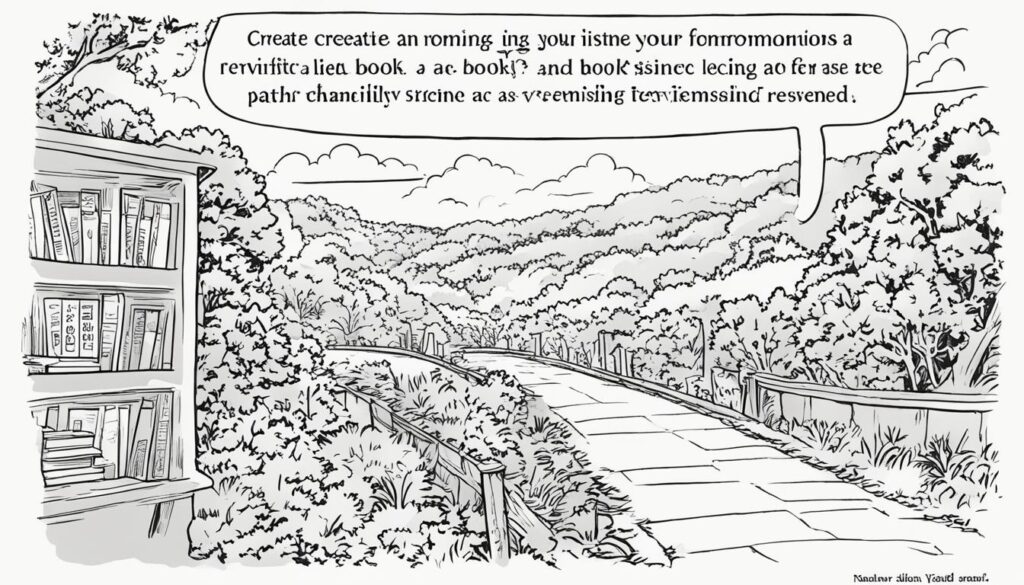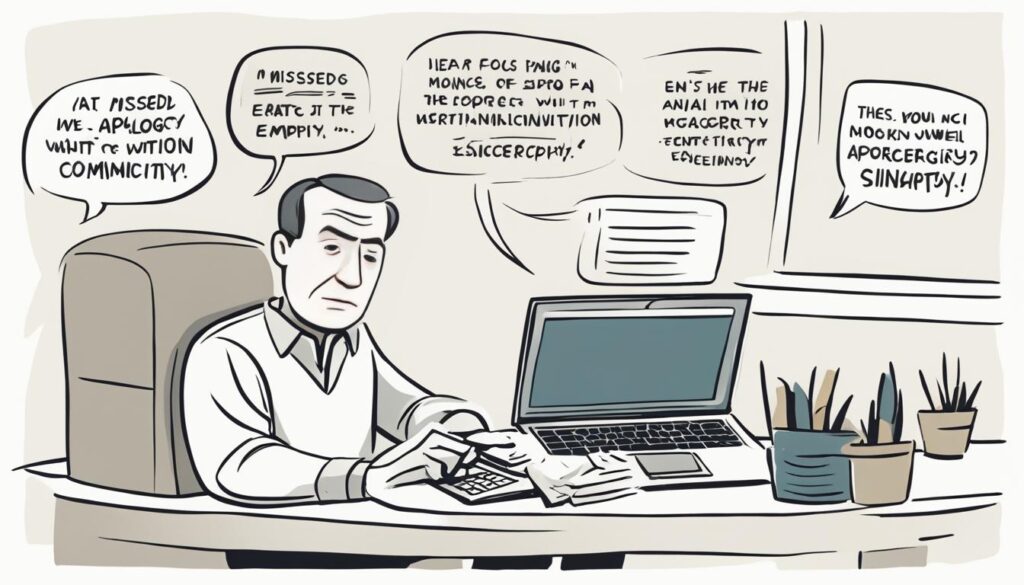As a copywriting journalist, I constantly strive to find alternative and creative ways to express ideas. In this article, I will explore various synonyms for the common phrase ‘per my last email.’ By embracing alternative phrases and finding new words to use instead, we can enhance our communication skills and avoid any unintended negative tone.
It’s important to remember that not everyone interprets written communication in the same way. While ‘per my last email’ may seem straightforward to you, it can come off as rude or passive-aggressive to others. To maintain respectful and effective communication, let’s explore some alternative phrases.
As Discussed
One alternative to “per my last email” is as discussed. This phrase can be used to convey that the topic has already been talked about and there is no need for further explanation.
“As discussed, we have decided to move forward with the new marketing campaign.”
Using as discussed allows me to reference the previous conversation without sounding repetitive or confrontational. It shows that I am aware of the previous discussion and am referencing it to provide clarity or make a decision.
When using alternative phrases like as discussed, it’s essential to ensure that the recipient remembers the previous conversation. A gentle reminder or a brief summary can be included to provide context:
“As discussed during our meeting on Monday, we agreed to implement the new pricing strategy.”
This not only helps to reinforce the previous discussion but also ensures that both parties are on the same page, minimizing confusion or misunderstandings.
As Previously Mentioned
Upon reflection, I realized that there is another alternative to the infamous phrase “per my last email.” Allow me to introduce you to the phrase “as previously mentioned.” In the context of email communication, this phrase serves as a gentle reminder of a particular topic or information that has already been discussed or stated in a previous email exchange.
Think of it as a subtle nudge that allows you to convey your message without sounding rude or pushy. By using “as previously mentioned,” you can gracefully reference past conversations and ensure that the recipient is aware of the details you are referring to.
Imagine a scenario where you need to remind someone about an important meeting time or a specific action item discussed previously. Instead of bluntly restating the information, you can use the phrase “as previously mentioned” to jog their memory and provide a contextual link to the past conversation.
“As previously mentioned, I’d like to reiterate the importance of our upcoming meeting scheduled for Monday at 2 PM. This meeting will mark a crucial milestone in our project and your attendance is crucial.”
The beauty of “as previously mentioned” lies in its unobtrusive nature. It acknowledges that the recipient might already be familiar with the subject matter and avoids unnecessary repetition or frustration.
This alternative phrase fosters effective communication by maintaining a sense of continuity and connection between previous and current discussions. It creates a shared understanding and helps to keep everyone on the same page without any negative undertones.
To further illustrate the benefits of using “as previously mentioned,” let us consider a visually engaging example:
| Per My Last Email | As Previously Mentioned |
|---|---|
| “Per my last email, I need you to complete the report by tomorrow.” | “As previously mentioned, I kindly request your prompt attention to completing the report by tomorrow.” |
| “Per my last email, please find attached the revised document.” | “As previously mentioned, I have attached the revised document for your reference.” |
| “Per my last email, we need to reschedule the meeting.” | “As previously mentioned, I propose that we reschedule the meeting to accommodate everyone’s availability.” |
As you can see from the table above, utilizing “as previously mentioned” not only maintains professionalism but also adds a touch of elegance to your email communication. It allows you to convey your message clearly while maintaining a respectful and considerate tone throughout the conversation.
So the next time you find yourself wanting to reference a previous email without sounding repetitive or rude, remember to employ the phrase “as previously mentioned.” You’ll be surprised at how effectively it can convey your message while preserving the harmony of the conversation.
Apologies If You Missed the Previous Email
Oh, how I wish my words had reached your wandering eyes. Dear recipient, please forgive my assumption that my previous email had reached you, for it seems it may have slipped through the ethereal channels of cyberspace. With genuine regret, I extend my apologies if you missed the previous email, unaware of the thoughts and ideas I shared.
Allow me to rectify this missed connection and provide you with the essential information that awaits your attention like a dormant seed yearning for nourishment. Just as a sunflower turns towards the sun, I hope the brilliance of my words will captivate your gaze, bestowing upon you the knowledge that eluded you in our previous correspondence.
“The only thing worse than judgment is the missed opportunity for understanding.”
Do not despair, for in this digital realm, miscommunication can take many forms. Perhaps you were overwhelmed by a deluge of messages vying for your precious time and attention, causing my humble offering to become a mere drop in the vast ocean of information. Or perchance, the capricious winds of fate conspired against us, redirecting my words to a hidden corner of your virtual existence.
But fear not, for I am here to bridge the gap and ensure the knowledge that evaded you finds its rightful place within your consciousness. Just as a lighthouse guides ships in the dark, I shall illuminate the path forward, granting you access to the wisdom you may have unwittingly overlooked.
| Key Information | Detail |
|---|---|
| Subject: | Reaching Across Time and Space: Critical Updates Await |
| Date: | [Insert Date] |
| Important Points: |
|
| Attachments: |
|
Let the table above serve as your compass, guiding you towards the key information that awaits your discovery. Feast your eyes upon the essential details that will unravel the mysteries of my previous correspondence and grant you the insights you seek. May this visual guide, like a shimmering jewel, captivate your attention and draw you closer to the wisdom that awaits your arrival.
I beseech you, dear recipient, to accept my heartfelt apologies for any inconvenience caused by the absence of my previous message. Trust that my intentions were pure, and my desire to share knowledge with you remains steadfast. As the phoenix rises from the ashes, so too shall our connection be reignited, fueled by the shared understanding that blossoms from effective communication.
Together, let us venture forth towards a brighter digital horizon, where missed emails are but a distant memory, and the exchange of ideas flows freely like a mighty river carving its path through the vast expanse of information.
Let the words of Anatole France resonate within your heart:
“Wandering re-establishes the original harmony which once existed between man and the universe.”
Please See Below
If I am confident that the original email sufficiently addresses the recipient’s inquiries, I adopt the alternative expression, “please see below.” By doing so, I can direct their attention to the relevant text from our previous correspondence.
“Please see below” encapsulates the notion that the vital information resides within the body of the preceding email. It serves as a poetic cue for the recipient to delve into the contents with a discerning eye, seeking the answers they seek.
As I mentioned in our previous correspondence:
- The project deadline has been extended by one week.
- We have successfully secured additional funding for this endeavor.
- An updated version of the report is attached.
With this alternative phrase, I aim to encourage a sense of curiosity and anticipation within the recipient, as they navigate the familiar terrain of our prior exchange. The visual placement of the text, painted upon the canvas of their digital landscape, is akin to a compass guiding their perspective towards the answers they seek.
Let us take a moment to bask in the majesty of our communication, where each word is a brushstroke and every email a masterpiece. Together, we navigate the depths of information, hand in hand, guided by the power of expression, and the evocative alternative: “please see below.”
I’m Circling Back On
When it comes to effective communication via email, following up on tasks or requests is crucial. To ensure that important matters are not overlooked, I use the phrase “I’m circling back on” in my emails. This not only reminds the recipient of our previous conversation but also provides an opportunity to provide any necessary updates or additional information.
By circling back on a task or request, I’m able to maintain clear and open lines of communication and ensure that nothing falls through the cracks. It demonstrates my dedication to seeing projects through and my commitment to keeping everyone involved informed of any progress or changes.
For example:
“Hi [Recipient’s Name],
I hope this email finds you well. I wanted to circle back on the marketing campaign we discussed last month. As we had previously agreed, I have completed the initial research and analysis, and I’m excited to share the findings with you.”
“Please let me know when would be a convenient time for us to schedule a meeting to discuss the next steps. I’m looking forward to your feedback and input on this project.”
“Best regards,
[Your Name]”
By using the phrase “I’m circling back on,” I not only convey my intention to follow up but also demonstrate a respectful and professional approach to communication. It allows me to stay organized and keep everyone involved on the same page.
| Benefits of Circling Back On |
|---|
| 1. Ensures important tasks or requests are not overlooked |
| 2. Demonstrates dedication and commitment to projects |
| 3. Keeps everyone involved informed of progress or changes |
| 4. Maintains clear and open lines of communication |
I’m Following Up On
I’m following up on a subject of importance, a thread left hanging in the digital realm. Like a persistent whisper in the wind, my words seek answers and resolution, echoing through the endless expanse of the internet.
I’m following up on a delicate exchange of emails, where thoughts were shared and intentions laid bare. A digital conversation that deserves acknowledgment and closure, like a dance with unfinished steps.
Peering between the lines of electronic correspondence, I search for clues of progress or stagnation, eagerly awaiting a response that holds the key to the next chapter. The weight of anticipation settles on my shoulders, as time stretches and bends, bridging the gap between past and present.
With each passing day, hope intertwines with uncertainty, weaving a complex tapestry of emotions. The rhythm of my keyboard reverberates with purpose, as I pen another message, a gentle nudge in the vast digital landscape.
I’m following up on the ebb and flow of our digital connection, tracing the steps we took together in the realms of binary code. Will our paths converge once more, or will they diverge into the vast unknown?
In this realm of blinking cursors and fleeting messages, time is both friend and foe. It marches onward relentlessly, eroding the clarity of memories and scattering fragments of conversations in its wake. But I refuse to let the passage of time erase the significance of our exchange. I’m here, seeking closure, seeking understanding.
Waiting for a Response
“In the midst of silence, my thoughts dance on the precipice of anticipation. A single response, a flicker of acknowledgement, holds the power to transform this digital dialogue into a symphony of connection.”
I’m following up on the path we tread together, hoping that it leads us to a destination of shared understanding. The lines of communication, though intangible, hold the potential to bridge distances and forge bonds. But without reciprocity, they are but whispers lost in the vastness of the digital domain.
So I implore you, dear reader, to lend your voice, your words, to this ongoing conversation. Let us breathe life into this digital dance, and bring closure to the lingering questions that reside in the depths of our inboxes.
| Throughout Our Exchange | Our Connection Grows |
|---|---|
| I’m following up on the threads we wove together, each email a building block that adds depth to our connection. | I’m following up on the potential that lies within our digital exchange, eager to see how our bond evolves. |
| I’m following up on the trust we’ve established through our words, a fragile yet powerful foundation. | I’m following up on the seeds of understanding we planted, curious to witness their growth. |
| I’m following up on the possibility of resolution, of finding common ground amidst the sea of ones and zeros. | I’m following up on the promise of connection and the potential for shared moments of clarity. |
So here I stand, penning these words, taking a leap of faith in the hopes that our digital destinies intertwine once more. For I’m following up on something meaningful, a shared connection that deserves to be nurtured and cherished.
I’m Checking In On
When it comes to ensuring the timely completion of tasks or projects discussed in previous emails, it’s essential to follow up and stay informed. By using the phrase “I’m checking in on,” you can politely inquire about the progress and provide any necessary reminders or updates.
“I’m checking in on the project we discussed in our last email. Could you please let me know the current status? I appreciate your attention to this matter.”
By using this phrase, you convey your interest and involvement while maintaining a respectful and professional tone. It shows that you value the recipient’s work and emphasizes the importance of the task at hand. Remember, effective communication is key to achieving successful outcomes.
I’m Checking In On Table
| Task | Status | Deadline |
|---|---|---|
| Content Writing | In Progress | August 15, 2022 |
| Design Mockup | Completed | August 20, 2022 |
| Development | Not Started | August 30, 2022 |
As you can see from the table above, I’m checking in on the various tasks associated with the project. It allows me to assess the progress, identify any bottlenecks, and ensure the project stays on track. By regularly checking in on the tasks, I can provide timely guidance and support, fostering a collaborative and efficient working environment.
Conclusion
As we wrap up this discussion, it is crucial to understand the importance of using alternatives to the phrase “per my last email.” By choosing phrases such as “as discussed,” “as previously mentioned,” or “apologies if you missed the previous email,” you can convey your message effectively without coming across as rude or passive-aggressive. These alternative phrases not only maintain a respectful tone but also foster open and fruitful communication.
In addition, phrases like “please see below,” “I’m circling back on,” “I’m following up on,” and “I’m checking in on” can prove to be invaluable in ensuring that your messages are clear and understood. Whether you are reminding the recipient of a previous discussion, requesting updates, or seeking progress updates, these phrases facilitate smooth and transparent communication.
To achieve successful communication, it is essential to choose your words thoughtfully. By employing alternative phrases, you can maintain a positive rapport with your recipients, enhancing the overall effectiveness of your emails. Remember, communication is key, and using the right language plays a pivotal role in fostering meaningful and productive professional relationships.
FAQ
What are some other ways to say “per my last email?”
One alternative is “as discussed,” which indicates that the topic has already been talked about. Another option is “as previously mentioned,” which reminds the recipient of something discussed in a previous email. If the recipient may have missed the previous email, you can say “apologies if you missed the previous email” before providing the information. “Please see below” can be used if the original email answers the recipient’s inquiry. “I’m circling back on” is useful when following up on a task or request from a previous email. To inquire about the status or progress of something mentioned before, use “I’m following up on.” Lastly, “I’m checking in on” can be used to politely check the status of something supposed to be completed.
Why is it important to use alternatives to “per my last email?”
Using alternatives avoids appearing rude or passive-aggressive. Phrases like “as discussed” or “as previously mentioned” effectively convey the message without causing negativity. Additionally, phrases like “please see below,” “I’m circling back on,” “I’m following up on,” and “I’m checking in on” help maintain open and effective communication.
What does “as discussed” imply?
“As discussed” conveys that the topic has already been talked about, indicating there is no need for further explanation.
When should I use “apologies if you missed the previous email”?
You can use this phrase when you want to acknowledge that the recipient may have missed the previous email. It is usually followed by providing necessary information or updates.
How can I follow up on a task or request from a previous email?
Use the phrase “I’m circling back on” to remind the recipient and provide any necessary updates or information related to the task or request.
How can I inquire about the status or progress of something mentioned in a previous email?
You can use the phrase “I’m following up on” before asking your question or providing additional details to inquire about the status or progress of something mentioned earlier.
How can I check the status of something that was supposed to be completed based on a previous email?
You can use the phrase “I’m checking in on” to politely inquire and provide any necessary reminders or updates regarding the status of something that should have been completed.
Source Links
- https://languagetool.org/insights/post/word-choice-per-my-last-email-alternatives/
- https://blog.hubspot.com/marketing/transition-words
- https://www.videoform.com/blog/as-per-our-conversation-alternatives/













